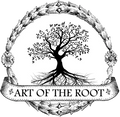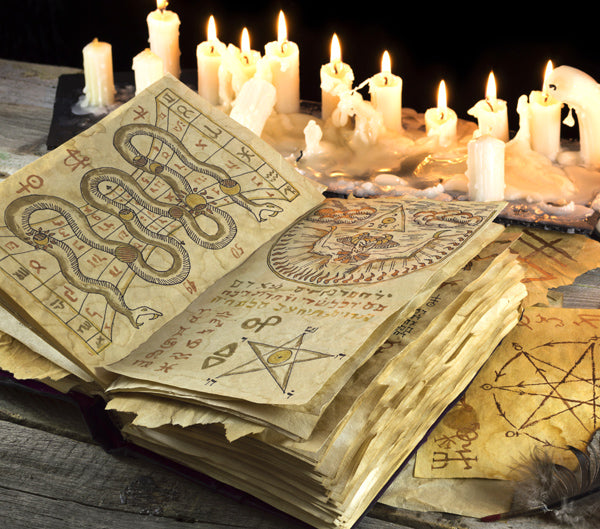Although witchcraft was officially condemned by the church during the medieval period, it still remained an integral part of society. Healing, Love & Unwitching magic remained active in many communities, and it was not uncommon to find an array of books that contained a series of rites, spells and ritual practices. These books are commonly referred to as Grimoires. In this blog, we will explore the most famous of grimoires and highlight a few of our favorite spells. Please keep in mind, the source material is obviously dated. The following spells have been adapted from their original sources.
Grimoires: 3 Famous Books of Magic
Grimoires were books of magic that contained spells, rituals and other information that was useful to practitioners of witchcraft. During the Middle Ages, there were many grimoires that were widely used by people who believed in the power of magic. Some of the most well-known grimoires of the time include the Key of Solomon, the Lesser Key of Solomon (also known as the Goetia), The Grimorium Verum and the Picatrix.
The Key of Solomon
The Key of Solomon Grimoire. Also known as the Lemegeton is a medieval grimoire attributed to King Solomon of Israel. It is believed to be written between the 17th and 18th centuries, although the exact date and author are unknown. The Key of Solomon features a collection of texts that purports to describe the methods for summoning and controlling spirits, demons and angels. It is divided into four main sections, known as the Lesser Key of Solomon, Goetia, Theurgia-Goetia, and Ars Paulina. The Lesser Key of Solomon details the methods for summoning 72 demons, while the Goetia describes how to control and command them. The Theurgia-Goetia provides instructions for summoning angels, and the Ars Paulina focuses on the invocation of angels for the purposes of divination and prophecy.
The Grimorium Verum
The Grimorium Verum was written in the late 18th century, but it’s spells and rituals were most likely sourced from older sources. The text which is attributed to an unknown author, purports to a be a translation of a lost grimoire from ancient Rome. The grimoire contains a wide range of spells and rituals including invocations to demon, instructions for divination and scrying and spells for love, wealth and protection. While some of it’s spells and rituals are similar to other grimoires of its time, the text is unique in its focus on the evocation of specific demons who are described in detail and assigned specific powers and abilities. Despite it’s ominous title which translates to the “True Grimoire,” the Grimorium Verum is often considered a more dark and dangerous text due to its malevolent tone.
The Picatrix
The Picatrix. Also known as the Ghayat-al-Hakim, is a medieval Arabic grimoire that was believed to have been written in the 11th or 12 centuries. Its is considered one the most influential works on astral magic in the Western world and has been studied by scholars, philosophers and magicians for centuries. The Picatrix contains a mix of astrology, magic, alchemy and Hermetic philosophy and aims to provide the reader with the knowledge and tools for controlling celestial bodies and using their powers for personal gain. The text is divided into four books and covers topics such as a talismanic magic, the creation of magical talismans, the properties of the planets and stars, and how to use astrology to predict the future. It also includes instruction on how to perform various rituals and invocations to communicates with celestial beings and to influence the natural world. Despite its focus on magic and the supernatural, the Picatrix was also influenced by ancient Greek philosophy such as Aristotle and Plato.
THE SPELLS
A Spell for Love
This spell is used to attract someone you desire or to rekindle feelings of love in a current relationship. The spell requires the following ingredients:
- A red piece of silk
- A red or pink chime candle
- A piece of paper
- A piece of string
- Come To Me Oil (optional)
On a piece of paper, write the name of the person you wish influence and write the words, “come to me” or something of this nature. Dab a few drops of Come to Me Oil on the paper. Fold the paper in half, making sure the paper is folded towards your body. Turn this to the right and fold it again. Do this one more time (3 times in total). Wrap the paper in a piece of red silk and tie it with string. Light your pink chime candle. As the flame takes hold, hold the silk charm directly over the flame (do not burn it) and recite the following invocation:
"Venus, goddess of love, hear my plea Bring this person close to me Awaken in their heart a flame That they may love me in your name."
The charm is then carried on the person or placed under the bed to bring the desired effects.
A Spell for Protection
This spell is used to protect the practitioner or someone else from harm, negative energies, and evil spirits. The spell requires the following ingredients:
- A piece of iron
- A piece of paper
- A piece of string
- Protection from Evil Oil (optional)
On the piece of paper, the practitioner writes the name of the person they wish to protect and the words "Protected by the power of iron." Dab a few drops of Protection from Evil on the paper. This paper is then wrapped around the piece of iron and tied with the string. The practitioner then holds the charm and recites the following incantation:
"Iron, the metal of strength and power Protect (name) in this darkest hour Against all evil, night and day Keep them safe, in your strong way."
The charm is then placed near the person or carried on their person for maximum protection.
A Spell for Healing
This spell is used to heal physical wounds or injuries. The spell requires the following ingredients:
- A piece of cloth,
- A piece of string
- A piece of mint.
The piece of cloth is soaked in warm water and then wrung out. The mint is then placed on the wound and the cloth is wrapped around the injury, tying it securely with the string. The practitioner then recites the following incantation:
"Herbs of power, mint so green Healing energy, make my wound clean Close my wounds, let pain subside So mote it be, by the power of the tide."
The practitioner should then leave the cloth in place for at least an hour. The cloth is then removed and disposed of in a body of water.
A Spell to Invoke the Spirits
This spell is used to summon a specific spirit and communicate with it. The spell requires the following ingredients:
- A piece of parchment
- A pen or quill
- A white candle.
On the piece of parchment, the practitioner writes the name of the spirit they wish to summon, as well as a request for it to appear and communicate with them. The parchment is then placed on the ground, and the candle is lit. The practitioner then recites the following incantation:
"Spirit (name), hear my call Come forth, and answer my call Appear before me, night or day And do as I command, I say."
After the incantation is complete, the practitioner should wait for the spirit to appear and respond to their request.
A Spell for Divination
"The spell for divination using a crystal ball":
This spell is used for divination and to receive answers to questions about the future or hidden knowledge. The spell requires a crystal ball, a quiet and dimly lit room, and the practitioner's ability to focus and concentrate. The practitioner should sit comfortably in front of the crystal ball and gaze into it, focusing their thoughts on the question they wish to ask. The practitioner then recites the following incantation:
"Gleaming sphere, of crystal bright Show me the truth, in your inner light Reflect the knowledge I seek to know And reveal the answers, to and fro."
The practitioner should then continue to gaze into the crystal ball and allow any images or impressions to form in their mind. These images or impressions can be interpreted as the answers to their questions.
Sources:
"The Key of Solomon the King" edited by S. L. MacGregor Mathers (1888).
"The Picatrix: A Medieval Treatise on Astral Magic" edited by Dan Attrell and David Porreca (2017).
"The Grimorium Verum" edited by Joseph H. Peterson (2007)
For further reading, check out these sources:
"Grimoires: A History of Magic Books" by Owen Davies (Oxford University Press) https://global.oup.com/academic/product/grimoires-9780199751166?cc=us&lang=en&
"The History of Grimoires: A Guide to Ancient Occult Books" by Jake Stratton-Kent (Inner Traditions) https://www.innertraditions.com/the-history-of-grimoires






Leave a comment